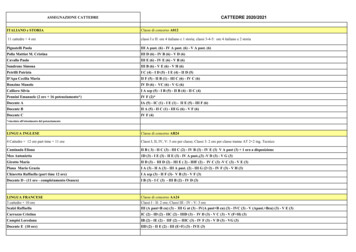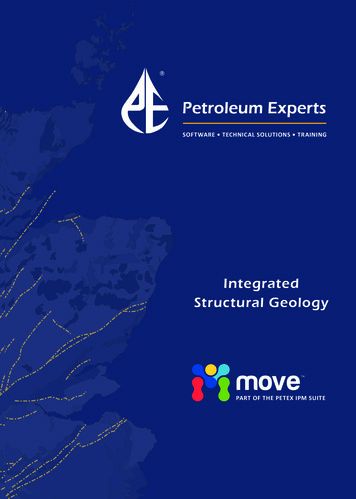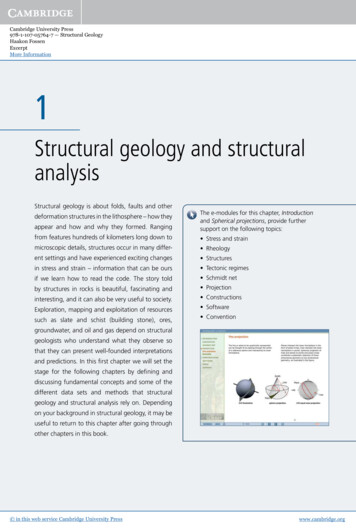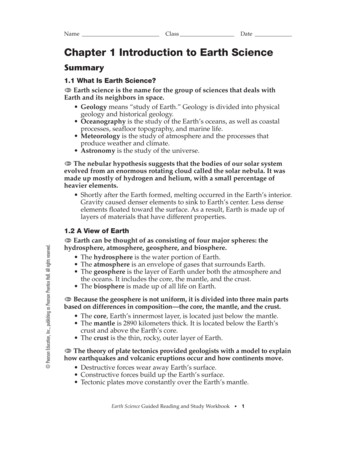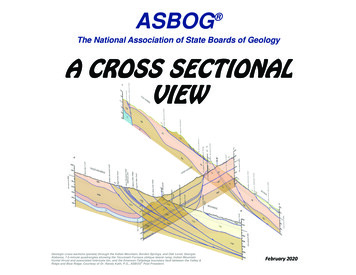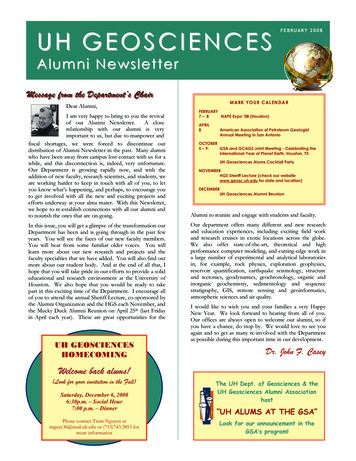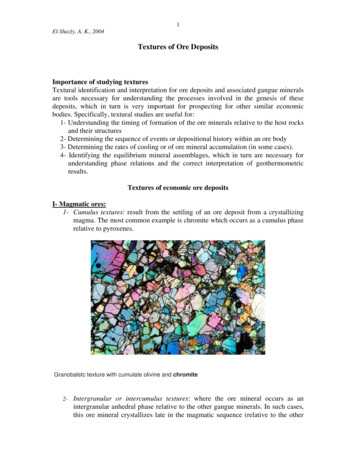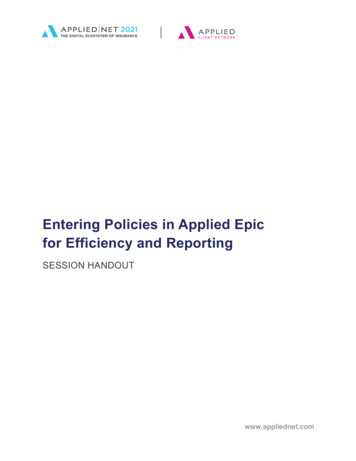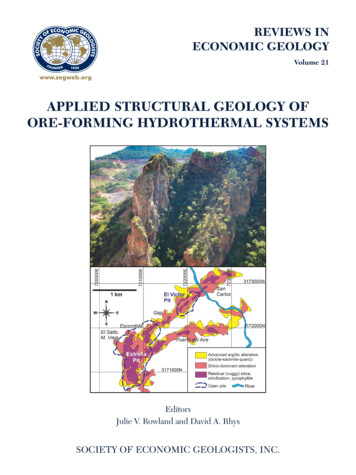
Transcription
REVIEWS INECONOMIC GEOLOGYVolume 21APPLIED STRUCTURAL GEOLOGY OFORE-FORMING HYDROTHERMAL SYSTEMSEditorsJulie V. Rowland and David A. RhysSOCIETY OF ECONOMIC GEOLOGISTS, INC.
REVIEWS INECONOMIC GEOLOGYVolume 21APPLIED STRUCTURAL GEOLOGY OFORE-FORMING HYDROTHERMAL SYSTEMSVolume EditorsJulie V. RowlandSchool of EnvironmentThe University of AucklandPrivate Bag 92019Auckland 1142New ZealandDavid A. RhysPanterra Geoservices Inc.14180 Greencrest DriveSurrey, British Columbia V4P 1L9CanadaSOCIETY OF ECONOMIC GEOLOGISTS, INC.
REVIEWS IN ECONOMIC GEOLOGYPublished by the Society of Economic Geologists, Inc.7811 Shaffer ParkwayLittleton, CO 80127, USAWebsite: segweb.orgE-mail: seg@segweb.orgPrinted by:Allen Press, Inc.800 E. 10th St.Lawrence, KS 66044ISSN0741–0123 (Print)2374–443X (PDF)ISBN978–1–629492–24–7 (Print)978–1–629495–79–8 (PDF)Reviews in Economic Geology is a series publication of the Society of Economic Geologists,originally designed to accompany the Society’s Short Course series. Each volume providescomprehensive updates on various applied and academic topics for practicing economicgeologists and geochemists in exploration, development, research, and teaching.On the cover: Front: Photo and plan map from the Mulatos district, Mexico, showing alteration zonation. The linear faultcontrolled alteration zones host gold mineralization in areas of resistant weathering with residual silica and silicification.Structural controls on epithermal gold-silver deposits are described in the paper by Rhys et al. in this volume. Back: Lowsulfidation epithermal quartz-adularia-calcite Au-Ag vein, Colorado Grande vein system, Midas Deposit, Nevada. The imageillustrates the textural and mineralogical evolution of the fault-hosted vein system during seismically induced dilational eventsthat contributed to the formation of the deposit. Photo by D. Rhys, August 2002. Copyright 2020, Society of Economic Geologists, Inc.
CONTENTSDedicationvPrefaceviiSponsorsixAuthor BiographiesxiChapter 1Structural Geology Applied to the Evaluation of Hydrothermal Gold DepositsT. G. Blenkinsop, N.H.S. Oliver, P.G.H.M. Dirks, M. Nugus, G. Tripp, and I. Sanislav1Chapter 2The Dynamics of Permeability Enhancement and Fluid Flow in Overpressured,Fracture-Controlled Hydrothermal SystemsStephen F. CoxChapter 3Structural Controls on Ore Localization in Epithermal Gold-Silver Deposits:A Mineral Systems ApproachDavid A. Rhys, Peter D. Lewis, and Julie V. RowlandChapter 4Internal and External Deformation and Modification of VolcanogenicMassive Sulfide DepositsB. Lafrance, H. L. Gibson, and M. S. Stewart2583147Chapter 5Creation of Permeability in the Porphyry Cu EnvironmentRichard M. Tosdal and John H. Dilles173Chapter 6Mechanical Regimes of Hydrothermal Gold MineralizationT. G. Blenkinsop, J. Rowland, and T. Baker205Chapter 7Structural Analysis of Drill Core for Mineral Exploration and Mining:Review and Workflow Toward Domain-Based 3-D InterpretationJulia Kramer Bernhard, Wayne Barnett, Ron Uken, and Russell MyersChapter 8Recognition and Integration of Structural Controls in 3-D GeologicModeling: Good Practice and Common PitfallsPaul Stenhouse, James Haythornthwaite, and Oliver JonesChapter 9Integrated Geologic-Geophysical Interpretation of District-Scale StructuralFrameworks: Systematic Approaches for Targeting Mineralizing SystemsJ. P. Siddorn, P. R. Williams, D. J. Isles, and L. R. Rankiniii215247271
DEDICATIONRichard H. SibsonEmeritus Professor of Geology, University of OtagoFellow of the Royal SocietyFellow of the Royal Society of New ZealandFellow of the Society of Economic GeologistsSociety of Economic Geologists R.A.F. Penrose Gold MedalistThis volume is dedicated to Richard H. Sibson, a teacher, storyteller, and intellect who has inspiredmany through his work at the nexus of structural geology and geophysics. Rick has illuminated ourunderstanding of crustal-scale fluid redistribution, active tectonics, and hydrothermal mineralization.v
2020 Society of Economic Geologists, Inc.Reviews in Economic Geology, v. 21, pp. viiPrefaceThe concept for this Reviews volume was initiated in 2013when Julie Rowland invited Dave Rhys to deliver a shortcourse on gold deposits—their structure and setting—tostudents, academics, and industry representatives at theUniversity of Auckland, New Zealand. Motivations wereundeniably selfish—Julie wanting to learn as much as shecould from Dave’s experience in applying structural geologyto gold deposits, and Dave keen to apply Julie’s knowledgeof the structure of the Taupo volcanic zone to a betterunderstanding of epithermal environments. We began talkingand realized that, although some excellent publications exist(e.g., the wonderful Reviews in Economic Geology Vol. 14,Structural Controls on Ore Genesis), there was a gap at theapplied structural geology end of the spectrum. Where shouldan exploration geologist or young researcher look for guidanceon applied structural geology?We ambitiously decided to pull together a Reviews volumeto provide guidance to working geologists and researcherstasked with applying concepts of structural geology to mineralexploration. Given our respective backgrounds and interests,we honed the scope down to ore-forming hydrothermal systemsand set about inviting top practitioners and researchers fromaround the globe to contribute their wisdom.The result is a volume that spans theory and practice acrossmineral deposit types at a variety of scales. The volume startswith two scene-setting chapters. First, Tom Blenkinsop, NickOliver, Paul Dirks, Michael Nugus, Gerard Tripp, and IoanSanislav demonstrate how principles of structural geology canbe applied to understanding hydrothermal gold deposits usingpredominantly lode gold case studies. They describe a classicworkflow with reference to examples and useful resources.Stephen Cox then delves into the processes that drive metalcarrying fluids through the accessible crust and optimize oreformation. This richly illustrated chapter considers feedbackbetween fluid flow and deformation and sets the theoreticalfoundation for understanding from a structural perspectivewhere and why ore formation occurs within hydrothermalsystems. Cox’s chapter provides the heft to underpin predictivestructural frameworks for targeting.Chapters 3 through 5 then provide first-class examples ofapplied structural geology specific to different deposit types.These three chapters were selected to illustrate contrastingstructural contexts with varying styles of behavior, influence ofhost-rock and deposit rheology, and proximity to a magmaticsource. In Chapter 3, David Rhys, Peter Lewis, and JulieRowland review structural controls on ore localization inepithermal gold-silver deposits. This chapter takes a mineralssystems approach, working from province to deposit scaleand complementing many of the concepts introduced byCox in the previous chapter. The lead author’s breadth ofexperience is on show here, with superb illustrations andplentiful photographs drawn from unpublished industrystudies that supplied unprecedented access to orebodies.Bruno Lafrance, Harold Gibson, and Margaret Stewartconsider ancient volcanogenic massive sulfide (VMS)deposits. This chapter highlights the important influence ofprimary features of deposits on the subsequent developmentdoi: 10.5382/rev.21.pre; 1 p.of tectonic structures. The rheological influence of sulfides iswell illustrated from thin-section to deposit scale. While thischapter focuses on a specific deposit type, the influence ofweak materials on deformational and hydrothermal history isrelevant elsewhere (e.g., timing of gold mineralization in lodegold deposits). In Chapter 5, Richard Tosdal and John Dillesapply a structural geologist’s lens to porphyry copper deposits,where the ore-forming environment is influenced by interplaybetween magmatism, tectonism, and hydrothermal flow. Thischapter illustrates the features and fabrics of porphyry copperdeposits using conceptual cartoons, selected photographs,and case studies acquired from the authors’ geographicallyexpansive experience.In Chapter 6, Tom Blenkinsop, Julie Rowland, and TimBaker draw on the preceding chapters to consider themechanics of hydrothermal gold mineralization. This shortchapter consolidates earlier observations and theoreticalconsiderations into a mechanical facies model for differentdeposit types—one that emphasizes considerable overlapin fields.The volume concludes with three unapologetically practicalchapters that illustrate good practice (and common pitfalls)in core shed or largely desktop aspects of exploration thatrequire a high quality of applied structural geology. InChapter 7, Julia Kramer Bernhard, Wayne Barnett, RonUken, and Russell Myers provide a thorough review of thestructural analysis of drill core for mineral exploration. Theypropose standardized workflows for data collection, reviewtechnological advances and quality control processes, andprovide an overview of structures that may be observed indrill core. This chapter illustrates a workflow toward domainbased 3-D interpretation.Paul Stenhouse, James Haythornthwaite, and Oliver Jonesfollow with a chapter that applies structural geology in thecontext of 3-D geologic modeling. They present a three-stepworkflow that includes establishing a geologic frameworkthrough field work and 3-D visualization, modeling theproject-scale geology, and finally, identifying, modeling, andunderstanding controls on ore shoots.Lastly, James Siddorn, Peter Williams, David Isles, andLeigh Rankin take us back out to the district scale withChapter 9, which reviews integrated geologic-geophysicalinterpretation of structural frameworks to target orogenicmineralizing systems.As everyone who has contributed to a Reviews volumeknows, it’s a long, hard process. We would like to thank all theauthors and reviewers, especially our industry and consultingcolleagues who took time away from the day job to makethis volume happen. Thanks also to all the sponsors for theirgenerous support, and the staff at SEG headquarters for theirdiligent conversion of raw manuscript to polished product. Wehope that we have at least partially achieved our ambition. Ifthis volume gets well-thumbed by a generation of explorationgeologists, especially those for whom structural geology is nottheir forté, we will be delighted.Julie Rowland and David Rhysvii
SPONSORSThe Society of Economic Geologists Publications Board thanks thefollowing sponsors for their generous financial support of this volume.SEG Publications BoardShaun L.L. Barker, ChairPilar Lecumberri SanchezPatrick Mercier-LangevinElizabeth R. SharmanRoss L. SherlockBrian G. Hoal, Executive Director, ex officioLawrence D. Meinert, Editor, Economic GeologyJ. Bruce Gemmell, Editor, SEG Discoveryix
2020 Society of Economic Geologists, Inc.Reviews in Economic Geology, v. 21, pp. xi-xivAuthor BiographiesTim Baker has been chief geoscientist for Eldorado GoldCorporation since 2012. Tim is a graduate of the Universityof Cardiff, Wales, and holds a doctorate in geology fromJames Cook University in Australia. He has over 20 years ofexperience working in industry, academia, and government,including research and academic positions at the MineralDeposit Research Unit, University of British Columbia,and James Cook University, and positions as director of theGeological Survey of South Australia and exploration managerof Sovereign Metals. In 2002 Tim received the Society ofEconomic Geologist’s Lindgren Award.John Dilles was born in California and earned degrees ingeology from Caltech (B.S., M.S.) and Stanford University(Ph.D., 1984). He has worked as an exploration geologistfor Hunt, Ware and Proffett and operated small gold mineswith his brother, Peter. He joined the faculty of Oregon StateUniversity in 1986, where he is currently professor of geologyin the College of Earth, Ocean and Atmospheric Sciences. Headvises graduate students and teaches courses in petrologygeochemistry, field geology, and minerals deposits. Hisresearch focuses on the geology of cordilleran porphyry copperdeposits, magmatic processes that generate metal and sulfurbearing hydrothermal fluids, field-based structural geology,and isotopic tracers and geochronology. He is a Fellow andSilver Medalist of the Society of Economic Geologists.Wayne Barnett is the principal consultant, structuralgeology, with SRK Consulting in Vancouver, Canada. Waynehas over 20 years of experience in mapping, interpreting, and3-D modeling of structural geology and has performed therole of consulting structural geology specialist in mining andexploration in Africa, North America, South America, Asia,and Australasia. Wayne has also been employed over a periodof eight years as a mining operations-based geotechnicalengineer and is keenly focused on developing improvedsystems for integrating good applied structural geologywith geotechnical design. He has provided formal appliedstructural geology training to over 1,000 geologists andengineers internationally, including specialized 3-D structuralmodeling training, and is currently driving the developmentof new innovative data collection technologies.Paul Dirks is professor of geology and codirector of the Economic Geology Research Centre at James Cook University,Townsville, Australia. He obtained an M.Sc. degree (geology) from Utrecht University (1987) and a Ph.D. degree (geology) from the University of Melbourne (1990). Paul is anelected Fellow of the Society of Economic Geologists. He is astructural geologist with an interest in the tectonic history ofcratonic terrains, investigating their evolution and associatedmineralization patterns. Paul’s research is field oriented with afocus on detailed mapping and field-based geologic analyses.Paul has worked extensively as a professional consultant to themining industry, is a past director of SRK-Zimbabwe and pastassociate of SRK-South Africa, and has served as an expertmember on mining and public projects. His consulting workhas focused on structural mapping, geotechnical work in openpits, and gold and base metal exploration.Tom Blenkinsop is a professor at the School of Earth andOcean Sciences, Cardiff University. He applies structuralgeology to the study of natural resources. His researchfocuses on faulting and fluid flow and structural controls onmineralization at all scales. He works extensively with theexploration and mining industry, mainly on copper, gold, andiron oxide copper-gold deposits. Tom graduated from OxfordUniversity and completed an M.Sc. degree at Imperial Collegebefore undertaking his doctorate at Keele University andpostdoctoral research at the University of California, SantaBarbara. He was a professor at the University of Zimbabweand then at James Cook University in Australia, where hewas director of the Economic Geology Research Unit. Hehas published over 150 papers, one textbook, and an onlinecourse in structural geology for exploration and mining. He isan editor of Ore Geology Reviews.Harold Gibson is professor of volcanology and ore deposits atthe Harquail School of Earth Sciences, Laurentian University.He was director of the Mineral Exploration Research Centrefrom 2002 to 2017 and is the founding director of Metal Earth.Harold’s research is field based and focuses on submarinevolcanism and volcanogenic massive sulfide ore systems,including the volcanology of epithermal precious metaldeposits. He has extensive expertise on volcanogenic massivesulfide deposits globally, including those of the modernseafloor, and has consulted for Canadian and Internationalmining companies and governments. Harold obtained hisB.Sc. degree from Queen’s University and his M.Sc. andPh.D. degrees from Carleton University. He is a recipient ofthe William Harvey Gross Award and the Duncan R. DerryMedal from the Mineral Deposits Division of the GeologicalAssociation of Canada, the Barlow Memorial Medal and theJulian Boldy Memorial Award from the Canadian Institute ofMining and Metallurgy, and the 2018 Research ExcellenceAward from Laurentian University.Stephen Cox is a professor of structural geology in theResearch School of Earth Sciences at The Australian NationalUniversity, Canberra, Australia. His research interests areprimarily in the coupling between deformation processes andfluid flow in crustal regimes, with applications to ore genesisand crustal mechanics. His research is pursued via field-basedstudies, microstructural, microchemical, and stable isotopeanalyses, high-pressure–high-temperature rock deformationexperiments, and numerical modeling. He holds a B.Sc.(Hons) degree from the University of Tasmania, Hobart,Australia, and a Ph.D. degree from Monash University,Melbourne, Australia. Stephen was the Society of EconomicGeologists Distinguished Lecturer in 2007.doi: 10.5382/rev.21.bio; 4 p.James Haythornthwaite is a senior consultant in resourcegeology at SRK Consulting (UK) Ltd. He completed a B.Sc.degree in geology at Durham University in 2009 and an M.Sc.degree in mining geology at Camborne School of Mines,University of Exeter, in 2011. James has worked as a resourcegeologist at SRK since 2011, specializing in 3-D geologicxi
Biographies (continued)modeling, resource estimation, and the interpretation ofstructurally complex mineral deposits. During this time, hehas worked on a large range of deposit styles and commodities,including iron ore, base metals, precious metals, and coloredgemstones, across Europe, Africa, South America, and Asia.to maximize insight from the data collected and accelerate thedrilling-to-model workflow.Bruno Lafrance is a professor of structural geology at theHarquail School of Earth Sciences, Laurentian University.His research focuses on the primary structural controls on theformation of ore deposits and their subsequent modificationduring orogenic events. Although most of his research hasbeen on gold and volcanogenic massive sulfide deposits,Dr. Lafrance also researched the structural controls on theformation and modification of Ni-Cu-platinum group elementdeposits in Sudbury, Ontario. Bruno holds a Ph.D. degree ingeology from the University of New Brunswick and a B.Sc.degree in geology from the Université de Montréal. In 1999,he joined the Department of Earth Sciences (now HarquailSchool of Earth Sciences) at Laurentian University, where heteaches courses in structural geology and field geology anddoes research in structural geology applied to ore deposits.Bruno was a member of the team who proposed the successfulMetal Earth project, the largest mineral exploration researchinitiative in Canadian history, and is now serving as associatedirector of Metal Earth.Dave Isles holds a B.Sc. (Hons) degree in geophysics fromMelbourne University (1975) and a Ph.D. degree in economicgeology from Adelaide University (1983). He has workedprimarily in mineral exploration since 1976 and has beeninvolved in projects for gold, base metals, diamonds, andiron ore in Australia and in Africa, Canada, India, the MiddleEast, and Southeast Asia. After completing a research projecton the Broken Hill region, New South Wales, in 1979, Davespent seven years with BHP Minerals as a project geophysicistand then joined airborne contractor World GeoscienceCorporation, specializing in the interpretation of aeromagneticdata. In 1993, he formed an independent consultancy andundertook directorships of junior mining and explorationcompanies. He has maintained substantial involvement withresearch and development and training activities, deliveringindustry workshops on aeromagnetic data and coauthoring abook on this topic. He currently is an exploration consultantwith Southern Geoscience and is a member of the AustralianSociety of Exploration Geophysicists and the AustralianInstitute of Geoscientists.Peter Lewis completed his B.S. degree at Stanford Universityin 1984 and his Ph.D. degree at the University of BritishColumbia in 1991, followed by a postdoctoral fellowship withthe Mineral Deposit Research Unit. He worked for 15 years asan independent consultant specializing in structural controlson ore deposits before joining Eldorado Gold Corporation in2009 in his current position of vice president of exploration.At Eldorado, Peter is responsible for the technical oversightand strategic planning of the company’s exploration programs,including project generation, early- to late-stage explorationprojects, and mine site exploration.Oliver Jones is a director at Impala Geomodelling, a 3-Dmodeling and mineral exploration consultancy based in theUnited Kingdom. He completed his undergraduate studies atCardiff University in 2008 and then spent the following fouryears with a Canadian junior exploration company, developinggold projects in Tanzania and Namibia. During this time, healso completed an M.Sc. degree in mining geology at theCamborne School of Mines. Oliver subsequently worked forfour years with SRK Consulting (UK) Ltd. as a resource geologyconsultant, focusing on 3-D modeling and exploration in avariety of commodities and deposit types. Oliver establishedImpala Geomodelling in early 2017 and currently works witha number of major and mid-tier producers across the globe,building complex 3-D models for resource estimation andexploration.Russell Myers is a mineral exploration consultant. Afterundergraduate studies in geology and geophysics at Universityof Missouri, Rolla, he obtained a Ph.D. degree in geologyfrom the University of the Witwatersrand. He subsequentlytaught at the Key Center in Economic Geology at James CookUniversity. He has been involved in mineral exploration andstructural controls on mineralization throughout his career.While working with AngloGold Ashanti, International TowerHill Mines, and Corvus Gold over a 10-year period, he andhis colleagues used oriented core extensively and, learning bymaking mistakes, developed robust methodologies for markingand QAQC of orientation lines, together with strategies foracquisition and analysis of structural readings. These orientedcore structural readings were instrumental in developing realtime geologic models affecting drilling strategies in a varietyof geologic settings.Julia Kramer Bernhard, Ph.D., is the lead of structuralgeology at Anglo American and provides structural geologicleadership and support to Anglo American’s operationsand exploration projects globally. She has over 25 years ofexperience in the mineral exploration industry, government,and academia and specializes in the structural controlof mineralization and the delineation of structures forgeotechnical rock mass characterization. Drawing fromextensive field experience, Julia visualizes geometries, modelconfidence, and alternative scenarios in integrated andvalidated geologic and uncertainty models. She championsthe development and implementation of structural geologictechnical standards for data collection and modeling at allstages of the mining cycle. Presently, she takes an interest inautomating data collection, correlation, analysis, and modelingMichael Nugus is a geoscientist with 25 years of practicaland strategic experience in gold mining, project development,value generation, and more specifically, characterizing geologiccontrols on mineralization in deposits from Australia, Ghana,South Africa, Tanzania, and Colombia. Following more than 18years in greenfields exploration and underground production,xii
Biographies (continued)Julie (JR) Rowland teaches structural and economic geologyat the University of Auckland, New Zealand, where currentlyshe is head of the School of Environment. JR started hercareer teaching physical education to high school studentsbut caught the geology bug after returning to university tocomplete her B.Sc. (Hons) degree under the guidance ofthe wonderfully enthusiastic K. Bernhard Spörli. She thenhad the good fortune to undertake a Ph.D. degree with RickSibson, who inspired her to focus on tectonofluid interactions.JR is particularly interested in heat and mass transfer withinextensional provinces and has worked in New Zealand,Ethiopia, Antarctica, and Chile.his more recent focus is to create spatially and geologically based,predictive models for resource estimation, mineral processing,and optionality within strategic projects—in particular, SunriseDam, Obuasi, and Quebradonna. He is currently employed byAngloGold Ashanti as the principal economic geologist for theStrategic Planning and Technical Group.Nicholas (Nick) Oliver is lead consultant and directorwithin the Australian consortium HCOV Global and adjunctprofessor at James Cook University. He has a B.Sc. (Hons)degree from the University of Queensland (1981) and aPh.D. degree from Monash University (1988). After positionswith the Commonwealth Scientific and Industrial ResearchOrganisation, Carnegie Institute Geophysical Laboratory,and Monash and Curtin Universities, he was professor ofeconomic geology at James Cook University from 1997 to2010, and director of the Economic Geology Research Unit.For the last 10 years he has been a full-time consultant to theminerals sector, focused on fusion of structural, geochemical,and geophysical data, centered on mapping and drill coreanalysis and training. He has broad commodity experience,from Au, Pb-Zn-Cu, rare earth elements, Fe, and U inPrecambrian polydeformed metamorphic belts (particularlyAustralia, Fennoscandia, Brazil, and West Africa) to porphyry,epithermal, skarn, and other Mesozoic to Cenozoic systemsin the Tethys, Mongolia, Southeast Asia, and South America.Ioan Sanislav is an economic geologist and codirector of theEconomic Geology Research Centre at James Cook University, Townsville, Australia. He obtained an M.Sc. degree (geology) from Alexandru Ioan Cuza University (2005) and a Ph.D.degree (geology) from James Cook University (2009). Ioan’smain research interest is in economic geology, structure, andtectonics with a focus on exploration for mineral deposits,field geology, and geologic mapping, structural controls onmineralized systems, and the interplay between tectonic process and mineralized systems. His experience includes lodegold, iron oxide copper-gold, sedimentary exhalative, manganese, and chromitite deposits as well as epithermal and porphyry systems.Leigh Rankin holds a B.Sc. (Hons) degree in geology fromthe University of Adelaide (1983). He joined the SouthAustralian Geological Survey in 1985 as a field geologist andsubsequently joined World Geoscience Corporation (1994) asa senior geologist, where he was involved with major geologicprojects in India and South America. In 1997, Leigh formedan independent consultancy specializing in the integration ofstructural geology and interpretation of geophysical data formineral and hydrocarbon exploration, with involvement inprograms in over 35 countries. He maintains a strong focuson training for both exploration and government surveygeoscientists, conducts workshops and on-site collaborativeprograms in interpretation of magnetic data, and is a coauthor(with David Isles) of a book on this subject. He is a memberof the Australian Institute of Geoscientists, the Society ofEconomic Geologists, and the Geological Society of America.James Siddorn holds a B.Sc. (Hons) degree in geology fromthe University of Durham (1995) and an M.Sc. degree (1999)in geology and Ph.D. degree (2011) in structural geologyfrom the University of Toronto. His Ph.D. work focused onthe structural geology of the Giant and Con gold deposits,Yellowknife, Canada. From 1995 to 1996 he worked forAlexander Gibb and Partners as a geologist in Newcastle-onTyne, United Kingdom. He emigrated to Canada in 1996,where he also worked as a geologist for the Government ofthe Northwest Territories (1998–1999) and the GeologicalSurvey of Canada (1999–2001). Since 2001 he has workedfor SRK Consulting (Canada) Inc., focused on the applicationof structural geology to mineral exploration and mining,including the interpretation of aeromagnetic data applied toexploration. James has undertaken projects in Australia, North,South and Central America, Asia, the Middle East, India,and Africa, covering orogenic gold, epithermal, porphyry,volcanic-hosted massive sulfide, magmatic Ni-Cu-platinumgroup element, and sedimentary exhalative deposits. He has adetailed knowledge of orogenic gold, volcanic-hosted massivesulfide (in particular the Iberian pyrite belt), and magmaticNi-Cu-platinum group element (in particular the Sudburybasin) deposits, as well as the regional- to deposit-scalecontrols on mineralization.David Rhys is a consulting geologist based in Vancouver,Canada. He studied at the University of British Columbiaand subsequently has worked since the early 1990s in themining industry, applying geologic studies with a structuralfocus to exploration, development, and mining. Mr. Rhyshas extensive experience in assessing ore controls on golddeposits, having worked globally on numerous gold districtsfor both major and junior companies, as well as evaluatingdistricts containing volcanogenic massive sulfide, porphyry,and uranium deposits. His focus is on advanced projects andactive mining operations, aiding in the interpretation of minesite ore controls and applications of mine geology to localand district-scale exploration activities, and the training ofgeologic teams.Paul Stenhouse is currently an independent structuralgeology consultant. He completed a B.Sc. (Hons) degreeat the University of Otago in 2002 and a Ph.D. degree atThe Australian National University in 2014. Paul worked asan exploration geologist for several precious and base metalexploration companies prior to his Ph.D. studies. Afterxiii
Biographies (continued)Ron Uken is principal consultant of structural geology withSRK Consulting in Vancouver, Canada. His specialization isin structural mapping and 3-D structural modeling of oredeposits. This includes the application of structural geologyto exploration, mineral resource estimation, geotech, andhydrog
Corporation since 2012. Tim is a graduate of the University of Cardiff, Wales, and holds a doctorate in geology from James Cook University in Australia. He has over 20 years of experience working in industry, academia, and government, including research and academic positions at the Mineral Deposit Research Unit, University of British Columbia,

